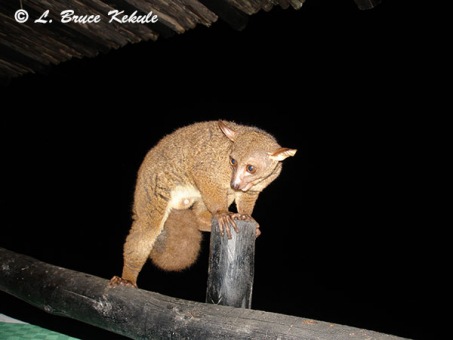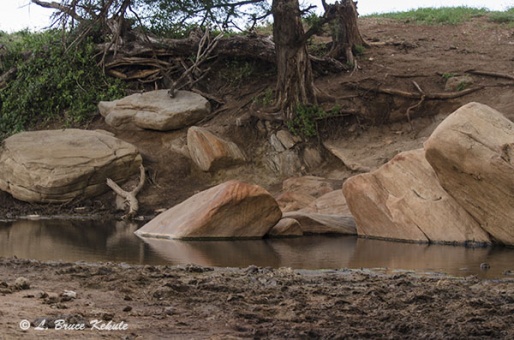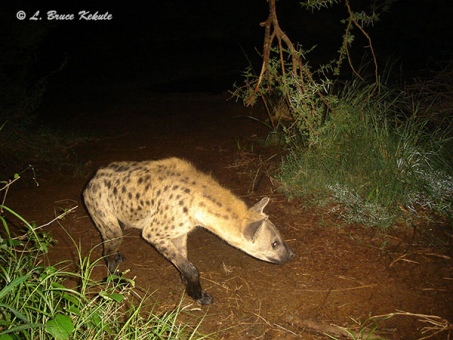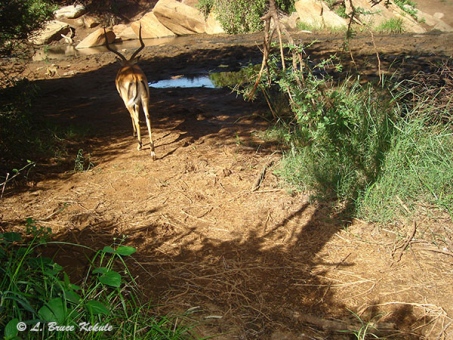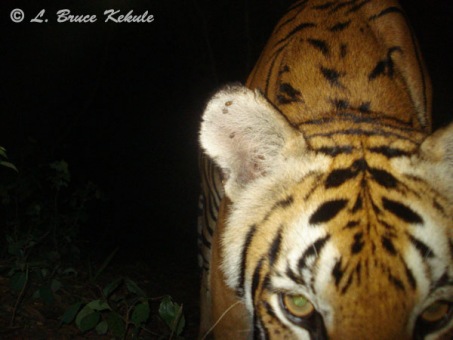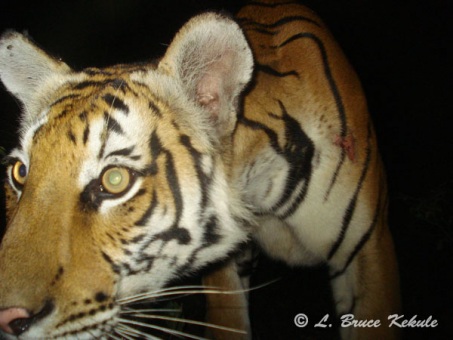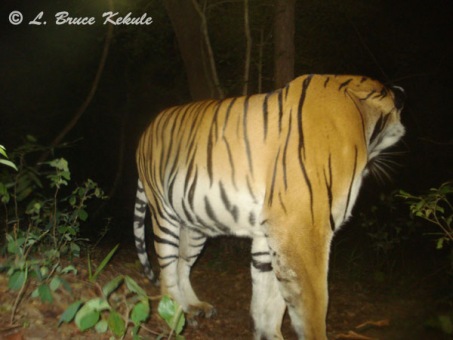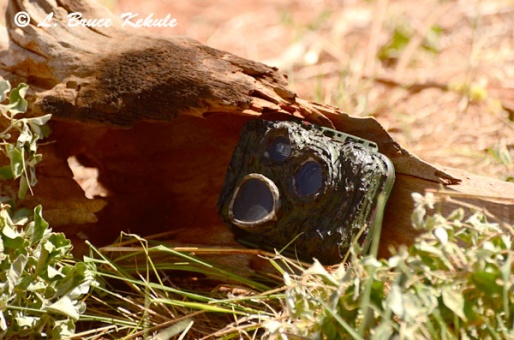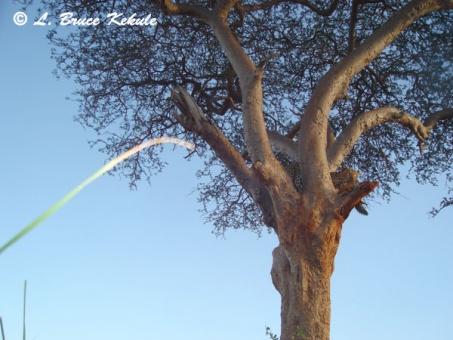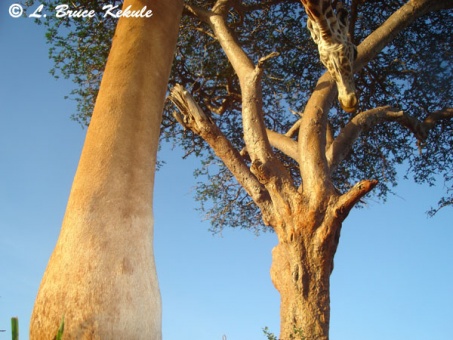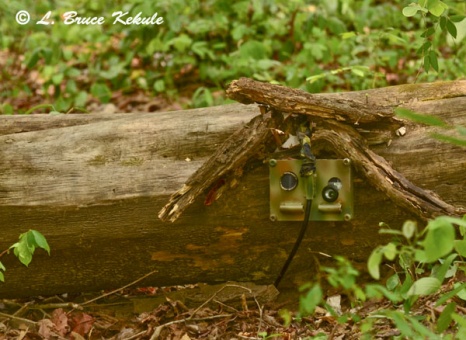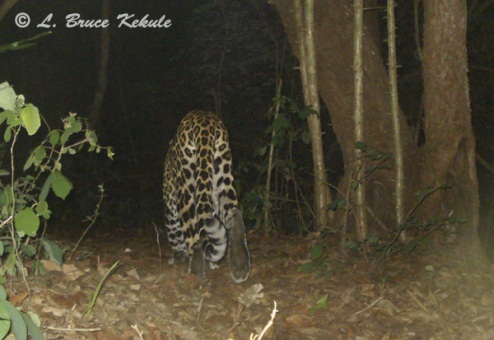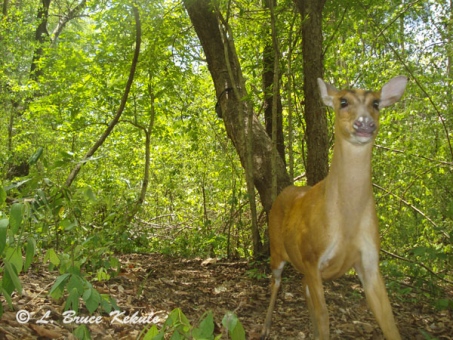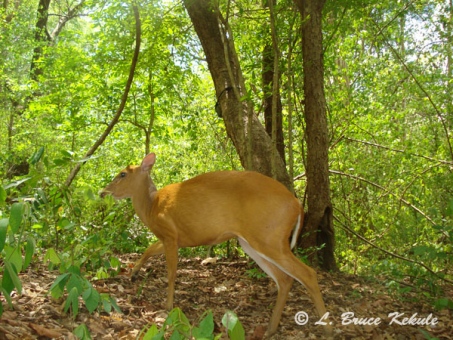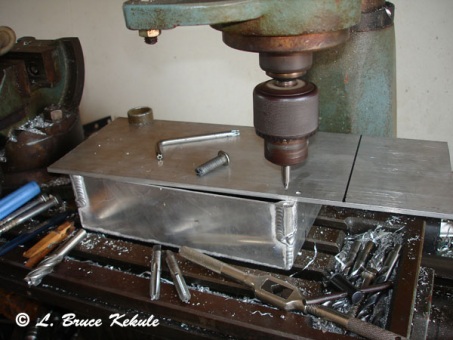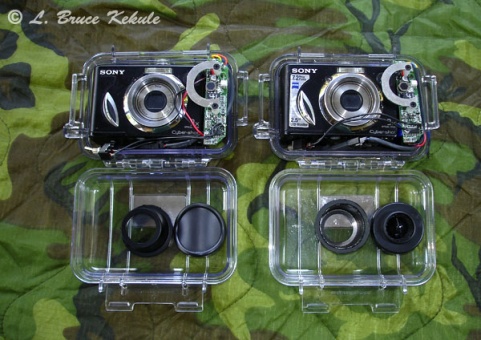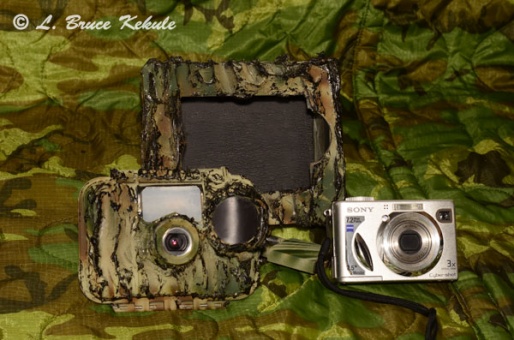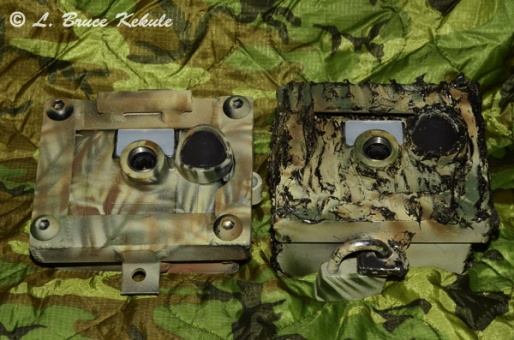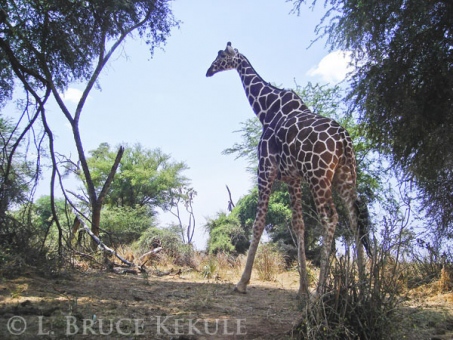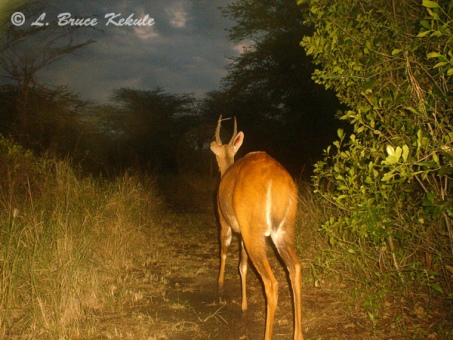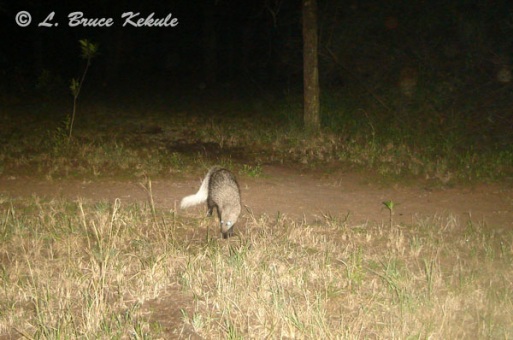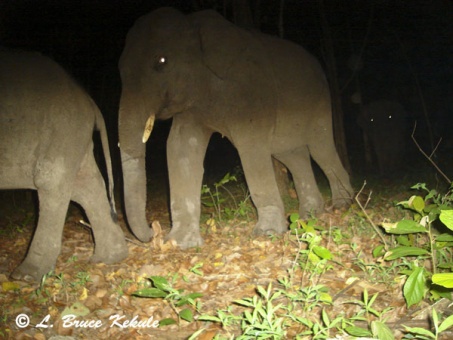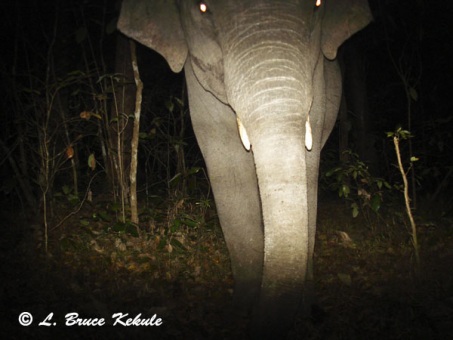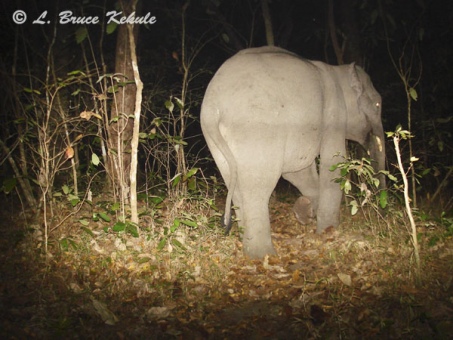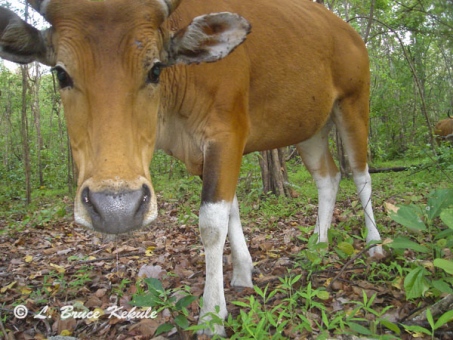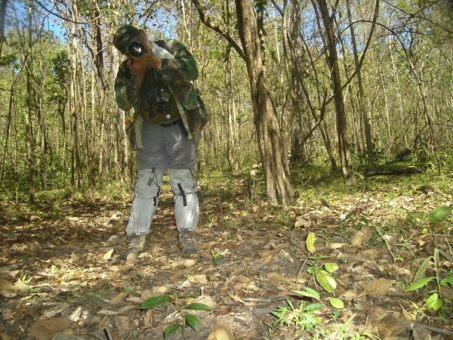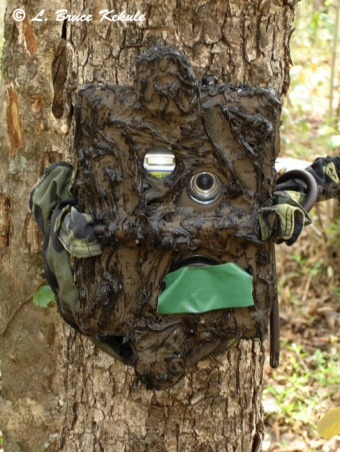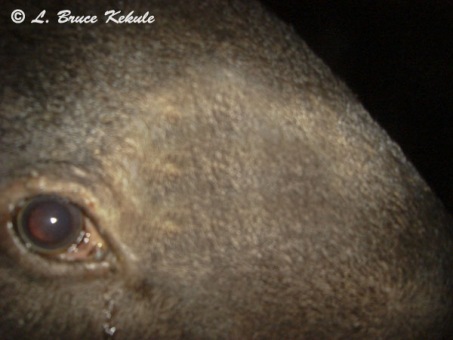Posts Tagged ‘infrared camera-trapping’
Sony W7 trail cam traps African elephant, giraffe and a bushbaby..!
More camera trapping in Kenya
Elephants and egrets in Amboseli National Park by the side of the road
For the last three years, I have made an annual photographic safari to Africa catching the ‘bug’ as they say. On my first trip in September 2010, I did not take any camera traps along but concentrated on ‘through the lens’ work. It was simply amazing seeing and photographing so many animals including the ‘Big Five’. I was with a group of Thai photographers. After visiting a few of the top protected areas in Kenya for 12 days, and taking more than 90 gigabytes worth of images, you can say I’m now addicted to this place.
In August 2011, I headed a new group of Thai photographers on safari. This time I took a few camera traps hoping to set them in the bush. The first hotel was a tented camp near the famous Masai Mara National Reserve (where the wildebeest and zebra cross the crocodile infested Mara River). The camp has wildlife running all over the place including the rare bushbuck, an antelope found in only a few places in Africa. Other creatures include mongoose and genet. See my previous thread entitled ‘Camera trapping in Africa’.
This year in May, I went to Kenya once again but this time down south to some new locations including Amboseli National Park near Mount Kilimanjaro on the border with Tanzania, and then to Tsavo (west and east) national parks (together they form the largest national park in the world), plus Shimba Hills Wildlife Sanctuary near the coast at Mombasa, and finally Taita Wildlife Sanctuary on my way back to Nairobi. It was once again terrific seeing and photographing some incredible creatures of nature.
Giraffes in Tsavo (West) National Park
This year I also took a W7/1010/SS1 cam with one of my custom ‘elephant proof-boxes’ as a double or back up to the Sony S600 trail cam mentioned in previous stories. Tough restrictions made it difficult to set them up. But at one location in Amboseli NP, there was a tree right next to the road and I quickly got down from the ‘Land Cruiser’ and slipped it on with a ‘Python’ cable with my camouflage sleeves and stuck some grass and leaves around it to break-up the outline.
I left it for two nights and picked it up on the way out of the park. Low and behold, two elephants had passed the cam. The distance was considerable but the sensor still got one shot in good light. I was pleased. We then headed to Tsavo (West) national park for a three-hour drive.
As we moved into the reserve, I found a tree with loads of ungulate tracks crossing the road. It was the same drill: get down and throw the cam on quickly with a Python cable and sleeves. I let this one soak for two nights and picked it up on the way out. A couple of giraffes were caught nibbling on some leaves and the W7 worked well. We then moved further East and I caught elephants but they were reddish from the red-colored clay soil found here.
Elephants in Tsavo (East) National Park: note reddish color from clay found here
We then motored down to what I would say is one of the worst roads I have ever traveled on in my entire life. For more than thirty kilometers, the road was potholed with some large enough to swallow a small car. Hundreds of truck trailers moving in and out of Mombasa on a daily basis (Kenya’s main port on the Southern coast) have destroyed the road and causes huge traffic jams.
It was hell getting through but my driver Patrick Mjoroge was very skilled having driven safari vehicles for more than 25-years. He knew how to weave in and out but I stayed ‘white-knuckled’ for most of the way. I tried to stay cool no matter what the conditions were but it was nerve-racking to say the least.
Male ‘bushbaby’ at the Shimba Hills Resort bar
We finally reached my 4th destination on this trip at Shimba Hills Wildlife Sanctuary past Mombassa. Being near the coast, it was lush and green unlike the hot dusty plains inland. The forest was thick but due to frequent patrols by rangers, I could not slip a cam in.
That night as Patrick and I were having our sun-downers and dinner, a male ‘bushbaby’ showed up at the bar. I immediately went to my room and got the W7. These small primates are semi-habituated and addicted to bread. I set-up my cam and left some bait. It did not take long to capture some candid camera trap shots.
Bushbaby: one of Africa’s smallest primates
In the event I travel to Africa again, I will surely be taking a couple DSLR trail cams and a few video cams. The opportunity to trap Africa’s exotic creatures on digital is great and I look forward to visiting Kenya once again. I hope those interested will enjoy this thread.
Camera trapping in Tsavo (West) National Park, Kenya
Trail Camera catches hyena, waterbuck, impala and baboon
Sony S600 trail camera at a stream in Tsavo (West) National Park
Before I departed for my annual safari to Kenya during May of this year, I decided to take my trusty Sony S600 trail cam with a Snapshotsniper SSII board in a Pelican 1010 case hoping to put it out in the field.
Stream in the interior of Tsavo (West) National Park
It is small and I knew I could depend on it to catch some interesting wildlife shots. Prior to trapping my ‘ghost leopard’ in Tsavo (East) with this cam, I visited Tsavo (West) National Park, southern Kenya.
Camera trapper testing S600 trail cam
One day while out on a ‘game drive’, my driver/guide Patrick Mjoroge and I stopped for a pit stop near a bend in a small stream close to the road deep in the interior. I got out to stretch my legs and walked on down to have a look around. There was a large group of baboons nearby and they were headed our way.
Waterbuck passing the cam on the first night
There were several trees next to what looked like a game trail by the little waterway so I quickly set-up the S600 using a ‘Python’ locking cable with my camouflage sleeves in conjunction with a ‘Snapshotsniper’ Pelican case locking bracket. I threw down some salami, meat and bread from dinner the previous night as bait. It was worth a try. We departed and left the cam for an overnight soak.
Hyena on the first night eating the bait
The next morning, we returned to the stream to check on the cam and for a boxed breakfast packed by the hotel consisting of two hard-boiled eggs, some bacon, sausage, bread, butter and jam, an apple, some juice and water. It was better than nothing but my mandate was to leave at dawn for early morning light, and since we were at least thirty kilometers away from the hotel, breakfast was out of the question.
Baboons caught on the second afternoon
The bread was not that good and the bacon was cold and greasy, so I decided to top-up the bait left the previous afternoon and left the cam out for one more night. No one could see the set-up from the road and I knew it was safe.
The same hyena the second night
The next morning as we were leaving the park to go further east, we headed straight to the stream to pick-up the cam. As I scrolled through the images, it was evident the bait had worked extremely well. A hyena visited the first night and ate everything except the salami (weird), and then came again the next night for the bacon and bread. I was extremely happy when I also saw a waterbuck, impala and baboon walking past the cam.
Impala passing the cam on the second day
Wherever there are baboons, there are leopards. I vowed that if I ever return to this place, I’ll bring one of my DSLR camera traps plus a small video-unit like a Bushnell Trophy Cam or one of my homebrew video units. Success is always sweet and I hope everyone enjoys this set-up.
Huai Kha Khaeng: A birthday tiger and leopard
A new Sony W55 trail camera catches the big cats
On May 19th (my birthday) 2012, I decided to celebrate in the forest after returning to Thailand from a two-week photographic safari in Africa. It was once again a great trip to the Dark Continent and I managed to photograph the ‘Big Five’ (three times now) plus a multitude of other animals including some rare species like black-mane lion, black rhino, striped hyena, sable antelope and bush baby. I also got many other common animals like elephant, buffalo, giraffe, zebra, warthogs and antelopes. I also managed to catch Mount Kilimanjaro when the clouds lifted. Kenya is absolutely one of the greatest natural spectacles on the planet and I look forward to returning next year.
A male leopard caught by a Sony W55 homebrew trail camera trap
However, there are still a few wild places in Thailand that harbor many magnificent Asian creatures such as tiger, leopard, elephant, gaur, banteng plus many other mammals, birds, reptiles, insects and plant species. Huai Kha Khaeng is one of the top wildlife sanctuaries in Southeast Asia, and the world for that matter.
Leopard caught again checking out the camera
To get there, it takes about five hours by vehicle from Bangkok and is tucked away in the forested mountains of central-western Thailand in Uthai Thani province. I have written many stories about this place and its wildlife, and it never fails to live up to its status as a ‘World Heritage Site’ but this time it turned out even better than my wildest dreams.
A young female tiger caught by the Sony w55 trail cam
My birthday wish to catch a tiger and leopard up-close with one of my camera traps was granted by the ‘spirits of the forest’ and all the hard work building the cams, setting them up, waiting while they soaked and then the pain-staking collection was truly worthwhile.
My favorite shot of this young tiger
Arriving early in the morning, I got everything ready and went out to check the cams. One location has been extremely productive and had been very lucky catching tiger and leopard almost every time (three months in a row). When I went through the photos on my new Sony W55/SSII/1020/3 AA externals, I could not resist shouting out loud with one big hurrah. A leopard had stopped at the cam for a few shots and a night later, a tiger posed for a whole series of close-ups from the low-down set-up. I was speechless for a few seconds.
Check-out the ticks and markings on the right ear
Remember this tiger eye and ear
This game trail is situated deep in the protected area and many animals use it to get to a mineral lick and waterhole. The balance of nature is in full force here and ‘eat or be eaten’ carries on everyday. There is a fallen tree right across the trail about 500 meters from the dirt road some 15 kilometers in the sanctuary.
More ticks and note the wound on the left shoulder
Both of these big cats jump this log as they hunt for prey but usually a few days or two apart. The leopard is a very mature male but the tiger is a young female that seems to may have finally left her mother. I have a close-up shot of this same cat captured together in March and identified it as the same tiger two months ago by markings on the right ear. What a coincidence!
Stripe-pattern on right side used to identify this cat
All I can say is: this has been the best birthday in many moons and I know that my prayers are really answered from time to time. It is hoped this young tiger will continue to live out its life in safety and carry on its legacy as the world’s largest cat. Huai Kha Khaeng is truly a remarkable place and I have not even scratched the surface of this amazing wilderness!
African leopard camera trapped in Tsavo East NP, Kenya
‘A Needle in a Haystack’: A Sony S600 catches a leopard eating prey
Sometimes, things happen that are unexplainable and spooky. That goes for the following story. I have just returned from Africa and while on safari, was able to slip two camera traps in the bush (a Sony S600 and W7) at several locations. But the weirdest setup was in Tsavo East National Park in Southern Kenya not far from the infamous ‘Man-eaters of Tsavo’ site.
To get a perspective of how huge this place really is (Tsavo – East and West) is the largest national park in the world at more than 43,000 square kilometers (the size of Wales, Israel and New Jersey). Finding a leopard is like finding the proverbial ‘needle in a haystack’.
Leopard’s prey: A wild cat and a black-backed jackal
One morning as my companion, driver and guide Patrick Mjoroge and I were out on a game drive (as they are known), he spotted two leopard kills hanging in a tree by the side of the road. We stopped and saw a wild cat wedged on top of a jackal in the branches, and both ‘dead as door nails’.
Sony S600/1010/SSII camera trap on the ground at the leopard tree
The big cat for a later meal stashed these two small predators and so we waited for a while but in vain. Then it dawned on me: why not just throw my S600/SSII/1010 on the ground in a hollow piece of dead wood pointed up at the big tree. It was worth a shot! Later that day, we drove by several times but the leopard was no-where to be seen.
A full-size image of the African leopard in a tree eating its prey
The carrion was still there so I decided to let it soak overnight until the next morning thinking the carnivore might come at night to eat its prize. I took a few shots of the hanging dead and the set-up, and we departed quickly not wanting to hang around obviously. The leopard on the ground is extremely fast and I was not sure how close it might be waiting, and we might just turn into dinner.
Bright and early the next morning, we drove directly to the tree and found the two kills gone. A small tree branch had fallen right in front of the cam and I thought I had missed the cat for sure. As I scanned through the images, I could see nothing but a large leg in several frames. A giraffe had almost stepped on the cam before we arrived and I could see its head up close to where the kills had been. I was a bit disappointed.
Giraffe at the leopard’s tree
Then, I decided to scroll through again and noticed one frame was darker just before the giraffe shots. I zoomed in and almost jumped out of the truck. Low and behold, I saw spots in the crotch of the tree and then saw the leopard’s head looking down towards the cam with the jackal in its mouth. The big cat had visited late in the afternoon and the background sky was nice and blue. I was speechless for a few moments until I could talk again.
Giraffe very close to the S600
I began jumping up and down in the back until Patrick told me to calm down. I showed him the shot and we both began celebrating this remarkable camera trap event. It definitely was worth several rounds of drinks or ‘sundowners’ as they are known in Africa later at the bar in the tented-camp.
Leopard close-up eating the jackal
Weird is an under-statement and the ‘spirits of the wild’ had answered my wishes. I have cropped and enhanced the leopard shot so it can be seen quite clearly. Remarkable is all I can say and the little S600 did a herculean job of catching a ghost!
More set-ups to follow: The S600 also traps hyena, baboon, impala, waterbuck, and the W7 catches elephant plus a bushbaby in a hotel bar getting the largest and one of the smallest mammals found in Africa. It was an amazing trip to the ‘Dark Continent’ as it was known in the old days, and hope everyone enjoys these camera trap photographs.
Huai Kha Khaeng ongoing camera trap saga
New camera trap gets a leopard and tiger first time out
Sony W55 in Otter 2000 case with a Snapshotsniper SSII board and 3 AA externals
The feeling of accomplishment is the best part of building a ‘homebrew’ trail camera and then sharing the photos with others. I am extremely lucky to be working in a place that is one of the top tiger reserves in the world, and is extremely productive for camera trapping. It is not only the tigers, but also other predators like leopard, wild dog and jackal, and their prey species such as deer, pig and wild cattle that makes Huai Kha Khaeng Wildlife Sanctuary truly special.
A leopard caught by the Sony W55 camera trap
When I first built this unit, I had one fallen tree across a trail in mind and it proved to be the right choice. I designed the cam to slip the 10mm ‘Python’ locking cable around the horizontal log. One of the first animals to jump over was a mature male leopard several nights after the setup. This frame filling shot is what I was hoping for.
Leopard caught again as it went down the trail
Several nights later, a tiger went over and the W55 caught its rear end as it disappeared down the trail. A female muntjac (barking deer) was also caught. This was after only a 15-day soak and shows the tremendous biodiversity of this amazing place. This unit definitely worked as designed: to scout a game trail with a low-down set-up.
Tiger caught going down game trail several nights later
The next order of business now is to build a Nikon ML-3 ‘active-infrared’ controlled SLR Nikon F5 film camera using Fuji Provia 400 ISO slide film, and a Nikon D2x DSLR and both can fire five shots a second in ‘continuous mode’ with several wireless SB600s or SB28s. These two cameras are my old prime camera bodies that I have kept over the years (they were really expensive), and I have resurrected them for this project. The Nikon D2x is now in the Nikon shop for an overhaul but will be finished real soon.
Female muntjac (barking deer) caught by the camera trap
My main objective is to catch the cats making the jump. I will eventually be installing both units close together on either side of this log about a meter or so away from the trail. The sensors need to be slightly angled away so as to activate them a bit early. Both cameras will be using an 18-35mm wide-angle lens (the zoom setting of the lens will be adjusted when installed) and that should help to catch these quick-acting animals. The units have to be precise and fast, and fire off a good string of shots with several flashes.
Muntjac spooked by the camera’s flash
The only negative aspect with active infrared at night; the first shot will not trip the flash but follow up shots will be OK. But I can also hard wire a flash for each cam with a sync-cable in conjunction with the wireless flashes and that should be enough. I will also experiment with a ‘passive infrared’ system that can wake-up the flashes in time for the shot. However, this is a hit and miss situation whereas active infrared is usually spot on and will trip immediately after the beam is broken.
The system will be modular so sensors and camera are separate, and they will be ‘plug and play’ units. That’s the plan anyway for this absolutely amazing wildlife game trail. I have all the parts ready; just finding time to put it all together is the next trick.
Got a very busy schedule with a trip to Africa and the States for the next couple of months. But I will be getting the SLR and DSLR camera traps up and running shortly after getting back to Thailand, and of course will post the builds. Most important: they have to be ‘elephant proof’ but I have that covered as usual.
Posted from Tsavo National Park, southern Kenya, Africa
HD Video Infrared Camera Trap
High-tech ‘homebrew’ video trail cam
A joint camera trap video program using a DXG 125r/1060/BF board-array video camera trap
Ron Davis DXG 125 video unit in a LBK elephant proof box
After seeing some of my posts, Ron Davis, a lawyer from Florida offered to send me an High Definition DXG 125R/BF board-array/IR/exchanger video unit housed in a Pelican 1060 (monster case) to put in Huai Kha Khaeng Wildlife Sanctuary where I’m presently doing a camera trap (presence/absense) survey. I gladly accepted the offer and waited patiently for the unit.
Machining elephant proof box
I have been running three Bushnell Trophy Cams (2009 & 2011 models) and was getting some amazing clips of large mammals like elephant, gaur, banteng, tiger and tapir plus other creatures at night, but also in broad daylight that was quite a surprise. I plan to share these videos with the forum soon. Most Asian animals are nocturnal for their own safety and have evolved this way due to centuries of human poaching pressure.
Drilling out LED ports on elephant proof box
However, as this World Heritage Site is being look after much better than any other protected area in Thailand, and its biodiversity is tops, wild creatures are beginning to feel more at ease about showing themselves during the day. It is a fact they will propagate and move freely in the day if undisturbed for the most part.
Video unit and elephant proof box before camouflage paint
I never have had a big Pelican 1060 and when it arrived in the post, my immediate reaction was it would be quite visible in the forest, and is also quite heavy with all the components including a 12v battery to run the array. However, I went to work building an elephant proof security box from aluminum.
Video unit and elephant proof and ‘Python’ locking cable ready for the field
I got my Tig-welder to make it up and did all the machining required. It was just in the outer limits of travel on the table of my small milling machine but it was OK. I had to do some juggling but I got it done using precision drilling with a center drill first followed by a drill bit, a hole-cutter and milling cutter. The LED ports took awhile to get all 12 finished.
I then painted it with a new camouflage technique for me. Using four colors (black primer coat, then khaki, army green and earth brown in conjunction with bamboo leaves (idea from my friend Chris Wemmer – the Camera Trap Codger), I painted the box in succession until I was satisfied. It looked pretty good to me and it certainly would blend in with the surrounding vegetation.
Ron Davis/LBK video unit at a waterhole in Huai Kha Khaeng
I made my monthly trip on April 15th to the sanctuary and the first night set the unit over a really bad smelling bag of rotten chicken (a previous bait and two weeks old)…whew! This was quite close to the ranger station I always stay at and early the next morning about 4am, I heard an Asiatic jackal barking close to the cam that could possibly mean a leopard. The bait was gone the next morning but I did not check the files deciding to wait.
I then moved it to a very productive water hole where it is now. When I return from Africa, I will be going straight in to check all my traps including this unit. Can’t wait to see what it has captured and will of course share any videos later on this website. I would like to thank Ron Davis for the use of his video unit and let’s see what it gets.
Two camera traps for Africa
LBK ‘Clear-View’ trail camera project: Twin W7/1010/SSIs
Sony W7s in Pelican 1010 cases with Snapshotsniper SSI boards
In 2008 when I first began building digital trail cams, I used several different models of Sony, Nikon and Canon cameras but found the Sony W7 to be one of the best producing very good quality photographs, both day and night, with its Carl Zeiss lens set to ISO 400 in ‘program’ mode. I actually use a W7 for general photography while in the field and have come to like this model even though it’s a bit large for a digital compact compared to newer models.
W7/1010/SSI components ready for building
The W7s are robust cameras that use two AAs and are fairly quick for all-round use. The only drawback; they are tough to hack and a steady hand, good eyes and nerves of steel is needed to modify these as the connections are tiny..! Check out Camtrapper.com and Buckshot164’s video tutorial on the W5-7, or the W1 for that matter (similar camera).
By using the Pelican 1010, they are truly ‘pocket size’. I normally use two ‘Energizer Lithium’ batteries that can usually last a month or more. I bought 8 W7s and built camera traps around six of them but kept these two for a special job one day.
W7/1010/SSI cam #1
I sourced the clear Pelican cases and managed to get some of Gary’s last SnapShotSniper ‘Simple Sniper’ boards before he discontinued them. I also ordered the metal sensor mount for easier installation with epoxy. By laying the camera and the 9-volt battery in the deep end of the case and the sensor in the shallow end, everything just fits.
W7/1010/SSI cam #2
The build is straight forward, and no hole is cut in the case for the flash allowing the camera to shoot straight through. A lens snorkel and HPWA is used and there are no externals. I have tested most of the cameras in this ‘clear view’ series and the power of the flash is not cut down by the case.
In fact on these builds as an experiment, I’ve installed a flash diffuser (cut from a Nikon SB26 flash diffuser) to cut back on harsh light sometimes caused by the factory flash. This idea came from an Olympus ‘dive housing’ for their U-700 digital compact shown here. My main objective with camera trapping is close frame filling shots that really show wildlife and the diffuser just softens the flash.
Olympus U-700 digital camera in an Olympus dive housing with a flash diffuser
A couple of aluminum boxes protect the W7s/1010s and a ‘Python’ 5/16” locking cable is used plus small ‘shark teeth’ are welded on the back to lock the cams in place on a tree. Holes are drilled to accommodate two lag bolts but these will not be used where I’m going, but later when I deploy these cams in the field here in Thailand. I have made-up one with 3D camouflage pattern and the other with 4-color camouflage paint job using fern leaves.
Completed trail cams ready for the field
I have built these two for my yearly African photographic trip that is coming up on May the 1st for two weeks. I will be going to Kenya once again, but this time will be visiting the great Amboseli (close to Mount Kilimanjaro) and Tsavo (East and West) national parks plus Shimba Hills Wildlife Sanctuary (especially after sable) and finally close out the safari at Nairobi National Park.
I hope to slip them in depending on local restrictions and laws, plus available wildlife and forests in the hotels and resorts where I will be staying on the fringes of the protected areas. In most reserves in Kenya, one is not allowed to leave the safari vehicle at any time or place other than in the hotels, and heavy fines can be incurred by the driver/guide (more than a $1,000 US dollars) if they are caught. It seems unjust but some people have already been maimed and even killed by this reckless behavior.
Detail of the drilled and taped box
In 2010, I slipped a trail cam in the bush and got a beautiful shot of a giraffe in Samburu National Park and then in 2011, got several shots of the rare bushbuck (both male and female), an African mongoose and a large-spotted genet plus a night patrol ranger with a .458 Winchester M70 express rifle at Siana Springs Tent Lodge near the Masai Mara Game Reserve. It was a neat experience.
Sony W7s and Sony S600 trail cams: ‘Python’ locking cable and camouflage sleeves.
These two Sony W7s and another Sony S600 are some of my smallest trail cams and just right to take with me while flying abroad. Being little, they are easily carried in my baggage and set-up will be quick. I will post any pictures at a later date.
Camera trapping in Africa
Capturing wildlife by camera trap while out on photographic safari
Reticulated giraffe in Samburu National Reserve: A lucky capture..!
In September 2010, I went on a photographic safari to Kenya’s protected areas including the Masai Mara National Reserve during the annual wildlife crossings at the Mara River, and then on to Lake Nakuru National Park and Samburu National Reserve. It was difficult to set trail cameras as the laws are very strict about leaving the vehicle while out on safari.
Finally, on the next to the last day, I got a quick chance to slip a camera in the bush off a dirt track by the river in Samburu. After three hours, my guide and driver said we had to retrieve the cam. Low and behold, a giraffe had passed the Sony P43/Bigfoot/1040/’C’ externals. It was a fluke and the shot shown here was the best of two. The lowdown set really enhances this very tall even-toed ungulate.
A rare male bushbuck during late afternoon in Siana Springs Tented Camp near the Masai Mara National Reserve
Then in August 2011, I was back in Kenya for another 12-day trip and the first three days was spent at Siana Springs Tented Camp next to the great Masai Mara reserve. The amazing thing about this place was the bushbuck, a very rare antelope, is found on the grounds. I asked for permission and set out three traps. After a couple of nights, a Sony S600/1020/SS1 trapped a ‘male bushbuck’, an African mongoose and a large-spotted genet. On another cam, I got a female bushbuck.
Male bushbuck camera trapped at night on the grounds of Siana Springs
On my older P43/Bigfoot/1040 with ‘C’ cell externals, I trapped a night patrol ranger as he passed by showing his boots, long coat and rifle….amazingly, it is a pre-64 Winchester Model 70 Supergrade in .458 Magnum ‘African’ model with express sights and a beautiful select walnut stock. What a rifle to have out on night patrol?
Night patrol ranger with a .458 Winchester M70 ‘African’ model. A rare firearm left over from the old days of hunting safaris
Some rich American hunter left this rifle with the old boy who was previously a tracker and guide for safari hunters in days gone by. I use to be a gunsmith and built many rifles from old shot-out Model 70s and Mauser 98s. I felt a bit of nostalgia, as this was my favorite caliber and I used a .458 Model 70 when I hunted with a gun here in Thailand but that was 25 years ago, and is another story. I’m still a hunter at heart, just switched from Winchester to Nikon, Minolta, Canon and Sony.
Female bushbuck along a trail on the grounds at Siana Springs
I’m off to Kenya once again on May 1st armed with my big Nikon D3s and a new Nikon 200-400 VR II telephoto lens. I will also be taking three camera traps and hopefully I will be able to set a few cams here and there as I know some tented camps usually have wildlife running around the grounds…plus the guards…..hmmmm!
White-tailed mongoose, a common carnivore
Large-spotted genet, another common predator
These three cams are the ones I’m taking with me to Kenya. The two in the back are Sony W7s in Pelican 1010 cases with Snapshotsniper SS1 control boards, and one in front is a Sony S600 in a Pelican 1010 with a SS1 control board. These cams are small and light, and easily packed in my luggage. I hope I can set them up…..that is the big question??
Camera traps ready for Africa
Huai Kha Khaeng: A camera trap saga
Thailand’s amazing forest with some beautiful, elusive and rare Asian creatures
Huai Kha Khaeng Wildlife Sanctuary is situated in central western Thailand, and is a World Heritage Site. It is the top protected area in the Kingdom. In January 2012, I began a camera trap program to determine the status of wildlife found here. In just a short two months, all the large mammals including elephant, gaur, banteng, tapir, tiger, leopard and many others have been caught by ‘homebrew’ digital camera traps set at various mineral deposits, water holes and game trails situated in the interior of the sanctuary. I have ten trail cams working through till March 31st, 2012. These are the best series. The following photos shows this amazing biodiversity, and this place is truly worthy of its ‘World Heritage Site’ status.
Set-up Number 1: A S600/1010/SSI was set above a water hole close to a ranger station. This cam turned out the most wildlife photos over a two month period. This mineral deposit and waterhole is visited daily by many animals and is one of the best in the sanctuary.
A Sony S600/Pelican 1010/SSI in an ‘Elephant proof ‘ box with a ‘Python’ locking cable
Mature female tiger
Tiger follow-up shot
Young tusker elephant in a herd
Tusker close-up
Tusker about-face
Mature gaur bull
Mature banteng bull
Younger banteng bulls
Mature banteng cow
Banteng cow close-up
Macaque monkey
Camera trapper
Set-up Number 2: Another S600/1010/SSI was set close to the ranger station and a bag of large rotten fish heads was strung up to prevent being taken by a scavenger like a water monitor. Amazingly, a leopard and a big wild boar, both scavengers, came to the bait. The bag can be seen in the boar picture. Boy did it smell..!
S600/1010/SSI in ‘elephant proof’ box with python locking cable.
Leopard male in the stream attracted by the ‘fish head’ bait.
Wild boar hoping for some carrion.
A crab-eating mongoose in the stream after the bait had been cut down.
Set-up Number 3: An old Sony S600/1040/BFOutdoors/2 ‘C’ cell externals in an ‘elephant proof’ box and ‘Python’ locking cable with 3D camouflage was used to catch this tiger mother and her cub (also caught by Bushnell Trophy Cam video twenty meters away). Other shots collected from this cam were deer at night not included here.
Sony S600 in a Pelican 1040 and BFOutdoors board with 2 ‘C’ cell externals
Tiger mother caught close to Subkaow mineral deposit and water hole
‘Eye of a tiger’ as this young cub has a chew on the cam…remarkable shot…!
Set-up Number 4: An older S600 with a Yeticam board in a 2nd generation LBK aluminum boxed cam plus tools for installation. Tiger, tapir and a sambar stag came along this trail about a day’s walk from the ranger station I stay at. This site will be covered by long-range cams with ‘C’ and ‘D’ cell externals for a three-four month period during the rainy season.
Old 2nd generation LBK trail cam in an ‘elephant proof’
housing firmly bolted to a tree with a ‘Python cable and 2 lag bolts.
Rear-end of a tiger along a game trail
Asian tapir at night
Tapir up-close and checking out the cam
‘Eye of a tapir’….not as dramatic as a tiger’s eye..but OK for government work..!
A mature sambar stag, Thailand’s largest cervid
Note: I still have more then ten trail cams working here at the moment including my new Canon DSLR 400D with three wireless flashes, and two of my new W55s. I will also be setting up a homebrew video very soon. I surely will be posting many more camera trap photos of this truly wonderful and magical wildlife sanctuary in the near future.
Another pair of camera traps for the forest
LBK ‘Clear-View’ trail camera project: A pair of W55s but in different cases
W55s in a Pelican 1020 and Otter 2000 cases with SS II boards and 3 AAs
This project came forth with a need for trail cams that could last longer than my customary time of one month between card checks, battery and desiccant replacement. I wanted a camera trap to last at least two-three months without visiting the site. Digital cameras with ‘AA’ externals are the ticket. Over the rainy season would be a perfect setup from August to late October when the forests in Thailand are almost inaccessible due to swollen streams and rivers, and constant rain.
The Sony S600 digital camera has become increasingly difficult to find in Thailand and as of this post, none are available here. But the W50, 55 and 80s and other cameras in the ‘W’ series are easier to get being slightly newer. Actually, I believe the S600 has dried up because of the huge demand for them on eBay and the U.S. homebrew trail camera market.
Sony W55s in Pelican-Otter cases with SSIIs and AA externals
The second-hand camera shops in Bangkok are in ‘Chinatown’ and many have loads of different models to choose from. I picked up two W55s for a song, ordered a couple of Gary’s amazing little SSII boards, found a Pelican 1020 plus an Otter 2000, both in clear, and triple ‘AA’ battery packs for these two trail cams. Everything fit easily and I put them together in my shop.
I built two ‘elephant proof’ boxes from 3mm sheet aluminum and had my welder ‘Tig’ it all together. I now have incorporated half-inch alloy rods welded into the corners for a cleaner look, and then drilled and tapped for 10mm ‘power torque’ machine screws. Faceplates are machined for lens, flash and sensor from 3mm aluminum plate.
Back-end of ‘elephant proof’ boxes with Stainless 3″ lag bolts and washers
An aluminum tube is welded to the front for a Python 10mm locking cable and what I call ‘shark teeth’ are welded on the back to lock the cam in place on a tree. Two 3/8” x 3” stainless lag bolts secure it from inside the box and the backs are beefed up with ¼” plate where the bolts are (see photo). These units have proven to withstand the carnage handed out by wild elephants or poachers that sometimes can be a disaster waiting to happen.
There is a mineral lick more than a days walk from the ranger station I work out of in Huai Kha Khaeng Wildlife Sanctuary. I intend to set these two cameras plus a few others with externals at this location and let them work for a couple of months. This should be an interesting set and I will post photos and set-up when the time comes.
Conclusion:
Both units with an upgrade to 3 AA battery packs
Sony W55/Pelican 1020/Snapshotsniper SSII/3 AAs: This unit is for normal installation on a vertical tree housed in an aluminum box. A camouflage paint pattern was applied to the ‘elephant proof’ box. A ‘Python’ locking cable runs around the front and secures the unit in conjunction with two 3” stainless steel lag bolts and washers from inside the box.
Sony W55/Otter 2000/SSII/3 AAs: This unit being horizontal is better suited to fallen trees across game trails and other suitable locations that require special set-up. The ‘Python’ locking cable can be run both ways (horizontal or vertical) and hence is slightly more flexible in installation. Lag bolts lock the cam on a tree and the 10mm ‘power torque’ machine screws close up the faceplate making these tough to get into or off a tree.
Note: I originally installed two ‘C’ cells and when turned on, they began leaking in a couple of days but I saved the camera and board just in time and the camera’s finish got slightly blotchy. I also had to remove the lens door which now works very smoothly. I then removed the ‘C’ cells and replaced them with 3 AAs packs. The internal components are the same for both cams and alkaline AAs will be used for externals. I look forward to setting these two up sometime next week and leave them for two-three months, and of course, will post any photos at a later date.






